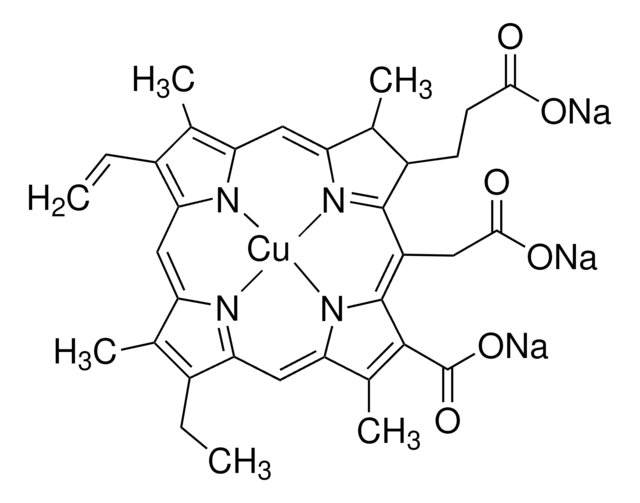If this product has an expiration or retest date, it will be shown on the Certificate of Analysis (COA, CofA). If there is no retest or expiration date listed on the product's COA, we do not have suitable stability data to determine a shelf life. For these products, the only date on the COA will be the release date; a retest, expiration, or use-by-date will not be displayed.
For all products, we recommend handling per defined conditions as printed in our product literature and website product descriptions. We recommend that products should be routinely inspected by customers to ensure they perform as expected.
For products without retest or expiration dates, our standard warranty of 1 year from the date of shipment is applicable.
For more information, please refer to the Product Dating Information document: https://www.sigmaaldrich.com/deepweb/assets/sigmaaldrich/marketing/global/documents/449/386/product-dating-information-mk.pdf
Select a Size
Select a Size
About This Item
Recommended Products
biological source
spinach
Quality Level
assay
≥85% (HPLC)
form
powder
impurities
chlorophyll b, essentially free
ε (extinction coefficient)
10.6-11.8 × 104 at 428 nm in diethyl ether (vs. 11.17 × 104, lit.)
8.2-9.1 × 104 at 662 nm in diethyl ether (vs. 8.63 × 104, lit.)
shipped in
dry ice
storage temp.
−20°C
SMILES string
CCc1c(C)c2cc3c(C=C)c(C)c4cc5nc([C@@H](CCC(=O)OC\C=C(/C)CCC[C@H](C)CCC[C@H](C)CCCC(C)C)[C@@H]5C)c6[C@@H](C(=O)OC)C(=O)c7c(C)c(cc1n2)n([Mg]n34)c67
InChI
1S/C55H73N4O5.Mg/c1-13-39-35(8)42-28-44-37(10)41(24-25-48(60)64-27-26-34(7)23-17-22-33(6)21-16-20-32(5)19-15-18-31(3)4)52(58-44)50-51(55(62)63-12)54(61)49-38(11)45(59-53(49)50)30-47-40(14-2)36(9)43(57-47)29-46(39)56-42;/h13,26,28-33,37,41,51H,1,14-25,27H2,2-12H3,(H-,56,57,58,59,61);/q-1;+2/p-1/b34-26+;/t32-,33-,37+,41+,51-;/m1./s1
InChI key
ATNHDLDRLWWWCB-AENOIHSZSA-M
Looking for similar products? Visit Product Comparison Guide
General description
Application
- to study the variation in carotenoids composition with changing colors and maturation in soybean seeds[4]
- to examine the use of chlorophyll distribution maps obtained from hyperspectral imaging for the non-destructive diagnosis of Nitrogen deficiency[5]
- as a standard to determine the concentration of the analyte by fluorescence spectrophotometric technique in the water sample collected from the yellow river[6]
- as a standard to quantify the amount of chlorophyllous pigments gathered from algae by high performance liquid chromatographic (HPLC) technique[7]
- in the identification of pheophytin a from environmentally friendly cultivated green peppers[8]
- to sense different nitric oxide (NO) species[9]
Biochem/physiol Actions
Packaging
related product
Storage Class
11 - Combustible Solids
wgk_germany
WGK 3
flash_point_f
Not applicable
flash_point_c
Not applicable
ppe
Eyeshields, Gloves, type N95 (US)
Choose from one of the most recent versions:
Certificates of Analysis (COA)
Don't see the Right Version?
If you require a particular version, you can look up a specific certificate by the Lot or Batch number.
Already Own This Product?
Find documentation for the products that you have recently purchased in the Document Library.
Customers Also Viewed
-
How can I determine the shelf life / expiration / retest date of this product?
1 answer-
Helpful?
-
-
How is shipping temperature determined? And how is it related to the product storage temperature?
1 answer-
Products may be shipped at a different temperature than the recommended long-term storage temperature. If the product quality is sensitive to short-term exposure to conditions other than the recommended long-term storage, it will be shipped on wet or dry-ice. If the product quality is NOT affected by short-term exposure to conditions other than the recommended long-term storage, it will be shipped at ambient temperature. As shipping routes are configured for minimum transit times, shipping at ambient temperature helps control shipping costs for our customers. For more information, please refer to the Storage and Transport Conditions document: https://www.sigmaaldrich.com/deepweb/assets/sigmaaldrich/marketing/global/documents/316/622/storage-transport-conditions-mk.pdf
Helpful?
-
-
Is my ampule intact? How can I tell?
1 answer-
If the meniscus "bubble" is not broken, then the ampule is intact and usable. To test the meniscus, use a glass Pasteur pipet and gently touch the bubble. If the glass pops and breaks, then the ampule was sealed. If it goes straight through to the bottom of the ampule with no resistance, then the seal was broken during transit.
Helpful?
-
Active Filters
Our team of scientists has experience in all areas of research including Life Science, Material Science, Chemical Synthesis, Chromatography, Analytical and many others.
Contact Technical Service




